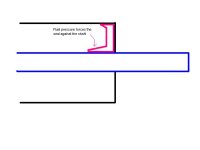BGL990
Gold Member
It's not necessarily an old wives tale. Depends on the design of the seals I think. Many seals have backup O-rings or actual springs coiled around the inside lip to help press them against the shaft. Many don't. Seals that don't may rely on fluid pressure behind them to force them against the shaft. If there is no pressure at all behind them, it is possible for them to seep a bit. I think it was somewhere here on TBN that I read about this happening with a forklift. Someone noticed a seepage in the lift cylinder of a forklift. Replacing the seals didn't help. The problem turned out to be that an employee was dropping the forks to the ground at night, relieving all hydraulic pressure in the cylinder and letting the seals seep. A rep. for the forklift company told them to keep it lifted up a couple inches when not in use and that solved the problem.
I have an old post pounder that blew a seal. The only replacement I could find came with an O-ring backup fitted in side it but that made it too stiff to insert into the cylinder cap. The company I bought the new seal from said to just remove the O-ring and it would still be OK because the hydraulic pressure would keep it tight when in use.
I think many quick connects use a similar mechanism - pressure behind the rubber seal in one connector forces it against the metal of the mating connector. The more pressure, the tighter the seal.
Edit: I added a crude drawing of what I'm talking about. If there is an O-ring or spring backup, it would be inside the seal lip where the arrow is pointing, but often fluid pressure and the rubber stiffness itself is all that presses the seal to the shaft.
I have an old post pounder that blew a seal. The only replacement I could find came with an O-ring backup fitted in side it but that made it too stiff to insert into the cylinder cap. The company I bought the new seal from said to just remove the O-ring and it would still be OK because the hydraulic pressure would keep it tight when in use.
I think many quick connects use a similar mechanism - pressure behind the rubber seal in one connector forces it against the metal of the mating connector. The more pressure, the tighter the seal.
Edit: I added a crude drawing of what I'm talking about. If there is an O-ring or spring backup, it would be inside the seal lip where the arrow is pointing, but often fluid pressure and the rubber stiffness itself is all that presses the seal to the shaft.

